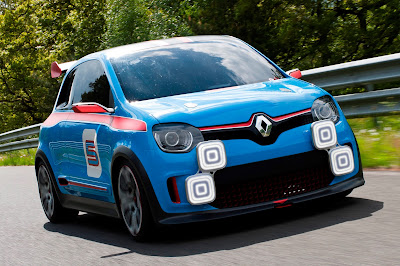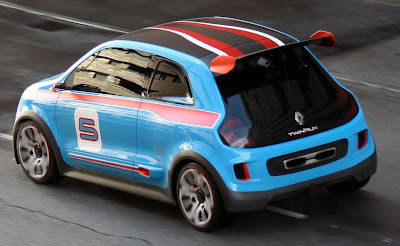The rumors were true: Renault’s new Twin’Run concept, which debuted today at the Monaco Grand Prix, does channel the spirit of the wild Renault 5 Turbo rally car of the 1980s.
Renault has hinted that the Twin’Run ties in with a string of concept cars dating back to the 2010 De’Zir, but this latest concept has more in common with the Twin’Z show car unveiled earlier this year. Although that car was a five-door battery-electric vehicle, it still drew its inspiration from the old Renault 5 subcompact. The Twin’Run – which bears a close resemblance to the Twin’Z – does the same, but specifically the 5 Turbo: a rear-engined, Alpine-assembled monster originally created for Group B rally racing.
 |
| Renault Twinrun Concept |
The Twin’Run’s shape and surfacing is almost identical to the Twin’Z, but a little more muscular and aggressive. The front fascia boasts a large, open lower air intake, and is topped with four square LED driving lights. The 5 Turbo’s blistering rear fenders are nowhere to be found, but large air intakes are tucked into the C-pillars, giving a hint to its mid-engine configuration.
 |
| Renault TwinRun Concept Front Three Quarters View on Track |
With the exception of the carbon fiber roof and wheel wells, the Twin’Run’s bodywork is fabricated out of fiberglass and then draped upon a bespoke tube-frame chassis. That framework is especially evident within the interior, despite Renault’s attempts at dressing up the cabin. A rounded, white instrument panel echoes the shape of the original R5 Turbo’s but boasts a large, multi-function LCD panel that replaces most mechanical gauges. The dashboard and door panels are trimmed in red Alcantara, while the bucket seats use the same faux-suede albeit in three different shades. Vive les 80s.
 |
| Renault TwinRun concept side view |
The cockpit is separated from the engine compartment by means of a plexiglass panel located just aft of the front seats. Unlike the R5 Turbo, the Twin’Run doesn’t use a small four-cylinder engine – or, for that matter, forced induction. Instead, Nissan’s VQ35 3.5-liter V-6 – the same engine found once found in the 350Z and Infiniti G35 — is planted amidship, and mated with a six-speed sequential gearbox. Power is then routed through a limited-slip differential to the rear wheels.
 |
| Renault Twin'Run Concept |
Renault says the 3.5-liter V-6 serves up 320 hp and 380 Nm of torque. That sounds somewhat pedestrian until you consider the Twin’Z is almost the exact same size of a Fiat 500, and tips the scales at 2100 pounds – 400 pounds less than a 500 Abarth. That crazy power-to-weight ratio allows for a 0-62 mph time of 4.5 seconds and a top speed of 155 mph. And, despite placing a large V-6 in the tail, the Twin’Run boasts a relatively even 43/57 front/rear weight distribution.
That’s pretty cool, but is it a proper successor to the R5 Turbo? According to Jean Ragnotti, former R5 rally racer and the man Renault hired to tune the Twin’Run’s handling, it certainly is.
“I’d say this is a sound car with a sound pedegree,” Ragnotti dished in a prepared press release. “It’s easy to control. All we need to sharpen our attacking edge a bit more are racing tires. There’s a slight roll but no understeer. There’s excellent traction with a responsive engine delivering full power at all revs, and with more torque than the R5 Turbo. [That] makes it particularly efficient and easy to drive, unlike the R5, which required more technique.”
That said, don’t expect this to follow in the R5 Turbo’s footsteps and become a production – or rally – reality in the near future.



